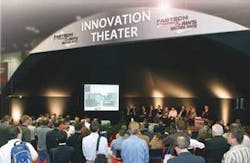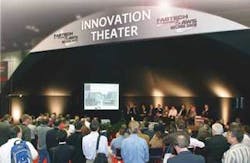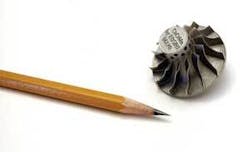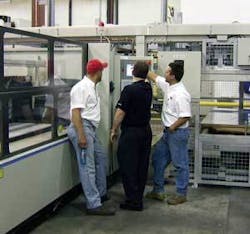Lasers at Center Stage
Atlanta, GA-Visitors to the Automated Manufacturing Laser Cell at FABTECH International & AWS Welding Show this year will see first hand the production of a trailer hitch cover. The Live Laser Cell is supported by members of the SME Industrial Laser Community (ILC).
The laser manufacturing demonstrations begin with tube cutting by BLM and flat sheet metal cutting utilizing a Bystronic flatbed cutter. Following these processes, an automated custom-built cell engineered and built by Custom Machines utilizing a TRUMPF 6K laser, Riedel chiller, American Laser Enterprises beam delivery, Precitec weld monitoring, and a Kawasaki robot is utilized to manufacture the hitch cover components. This end product will then be laser marked by Telesis Technologies and finished with Lasag’s precision welding equipment. The purpose of the Laser Cell is to showcase laser technologies and applications such as laser cutting, welding, and marking. In total, more than 15 companies will participate in the hitch cover production.
The ILC has worked with SME and FMA staff to better visualize the laser processes with added value programs to compliment the laser cell experience. A new Tech Tour concept is included as part of the newly expanded Laser Education Track at this year’s educational conference. A Tech Tour combines classroom instruction with an expert-led tour of the automated laser manufacturing cell. Participants will spend some of their class time in a classroom, but the remainder will be spent on the show floor in the ‘tech tour,’ where they will see live demonstrations of the technology they are studying. Each program is two hours in length.
Topics include Roadmap to Using Lasers on the Shop Floor, Precision Laser Applications, High Speed Laser Processing, and Breakthroughs in Laser Technology.
Additionally, the Industrial Laser Community will be presenting a free one-hour program called Lasers 101 in the Innovation Theater. This program is designed to introduce the audience to the variety of ways laser technology is currently being used in manufacturing, as well as predict the new uses for lasers that are on the immediate horizon.
The 2006 FABTECH International & AWS Welding Show will take place here at the Georgia World Congress Center from October 31 through November 2. For more information, visit www.sme.org.
Superalloy extends DMLS applications
Novi, Michigan- Morris Technologies Inc. (www.morristech.com), a manufacturer of laser-sintering systems, has recently expanded its applications for Direct Metal Laser-Sintering (DMLS) with a new superalloy material, the EOS CobaltChrome MP1.
EOS/Morris Technologies
Citing high strength, high temperature, and corrosion resistance as the main advantages when making prototype and test parts with cobalt chrome, Morris Technologies was the first U.S. organization to install an EOSINT M class machine. According to the company, client reactions to cobalt chrome have been well-received. Morris believes that the properties of the material have created new opportunities for DMLS and cites that aerospace and medical applications will be its early focal point.
Past experience determined that cobalt chrome parts are fully dense and that there is no variance in properties throughout the pieces. The material builds well, processes easily, and requires only minimal work to deliver a smooth surface finish. Morris comments, “We have recently purchased two new EOSINT M 270 systems to handle the workload, and anticipate additional purchases as demand dictates.” With the CobaltChrome MP1 now commercially available, the demand for cobalt chrome has increased substantially.
Diabolical puzzles, devilishly difficult
New Orleans, Louisiana- Diabolical Puzzles LLC (www.diabolicalpuzzles.com) is a small firm that designs metal jigsaw puzzles using computer aided design (CAD) and are manufactured using state-of-the-art laser cutting, welding, and fabrication technology. The hard-to-solve puzzles are cut to tolerances of 0.004 inch from solid metal using a 5200-watt Bystronic Byspeed 4020 laser. This laser cutting machine has the capacity to cut up to a 6 x12 foot sheet of metal and produces higher productivity than a conventional laser. The Bystronic Byspeed has two interchangeable tables to keep the workflow moving by off-loading one table while cutting the puzzle pieces on the other.
Owner and artist Scott Fredrickson reports that each laser-cut diabolical puzzle is unique in its own way. Rated on a 1-5 scale of difficulty, each one has a unique solution. This computer designed, laser cut puzzle is one-of-a-kind. Fredrickson says, “I was able to develop new techniques and methods to deliver a wonderful product that has not been duplicated anywhere else in the world.”
ICALEO celebrates 25 years
Scottsdale, AZ-In 1981 the Laser Institute of America (LIA), acting under an initiative enacted in 1978 by then President David Belforte, organized and sponsored an International Laser Processing Conference (ILPC) in Anaheim, California. This was not just another conference. In reality it was the first time that an international conference on the subject of laser materials processing was convened. And more importantly it brought together a number of then divergent laser societies in Japan, a nation that was becoming a developing power in industrial laser materials processing, with the LIA to present to an international audience the most advanced laser processing technology. This conference was a resounding success, drawing attendance from Europe, Japan, and North America in one venue to share technology advances.
Immediately after that event Dr. David Whitehouse, then president of the LIA, suggested to his Board of Directors that the ILPC success should be the springboard for an annual event to be called the International Congress on Applications of Lasers and Electro-optics (ICALEO). The first ICALEO, held in Boston in 1982, expanded the presented papers to include many from European process developers. Key to the success of ICALEO was the cooperating societies, on three continents, who worked to draw the international audience to various venues where succeeding events were held.
ILPC drew about 125 attendees to hear 33 papers in a single-session format over two days. ICALEO 2005, held in Miami, just days after a devastating hurricane hit the area, drew hundreds of attendees to hear more than 200 papers in a multi-session format.
From its modest beginnings ICALEO has grown to be one of the most important and prestigious international forums for the presentation of advanced laser materials processing technology. This year the 25th anniversary event will be held in Scottsdale, Arizona, October 31 to November 2. As established in the beginning it will bring together hundreds of international attendees who share one common interest, the employment of lasers in materials processing applications. It is a not-to-be-missed event and those interested can contact the LIA ([email protected]) for details.-DAB
CCAT update
East Hartford, CT- Much has happened at The Connecticut Center for Advanced Technology (CCAT) since we last reported in May 2005. We recently met with Dr. Terri Marsico, who in February was named CCAT Laser Applications Lab Director, for an update on activities at the center. Among other developments, she was pleased to announce that at the end of August Paul Denney joined the CCAT Laser Applications Lab as a senior researcher.
CCAT works in collaboration with U.S. government, industry, and academia to strengthen technology-led innovation and global supplier competitiveness. Shortly after our last report, CCAT was named the Air Force’s Program Manager of the National Aerospace Leadership Initiative (NALI) led by CCAT NALI Director Dr. Karl Prewo. The first grant was received June 15, 2005, and the second was received June 1, 2006. NALI was established to respond to critical needs of the US Aerospace Manufacturing Supply Chain.
The Air Force’ NALI Task III, “Next Generation Manufacturing,” is funding the CCAT Laser Applications Laboratory for these reasons: to bridge the knowledge and technology gaps in laser education by working with universities and businesses to offer more courses in laser; to bridge the gap in successful implementation of developed laser processes for production in aerospace OEMs and the supply chain; and to promote entrepreneurial innovation and increase domestic supplier global competitiveness. The CCAT Laser Applications Lab is a facility where a supplier can perform feasibility studies or take current processes to the next level.
Current laser equipment includes a seven-axis laser drilling work cell coupled to a Convergent Prima P50 and a GSI JK704TR; an IPG Photonics YLP-1/100/20, a Nutfield Cipher V10, a Coherent Gem Q700, and a Coherent Gem 100A for micromachining and marking, and a TRUMPF Powerweld.
Next-generation equipment at the facility includes a DMG Lasertec 80 Powerdrill Shape containing a Rofin Sinar 100, which arrived on July 27. An IPG Photonics 10kW high-power fiber laser was to be delivered by the end of August.
The Laser Applications Lab completed characterization of the Beta ExOne/General Atomics Superpulse Laser System for an Army Research Lab Project in July and the final report is being generated. The Beta ExOne is now located at the ExOne facility in Irwin, PA. The lab’s first intern, Bobby Wright, an MS mechanical engineering student at University of Hartford, worked on characterization of the Beta ExOne and on the P50 in developing CCAT’s baseline database.
In other news, CCAT NALI has hosted several meetings for the Metals Affordability Initiative (MAI) Consortium and is working in collaboration with team members Pratt & Whitney, GE, and Rolls Royce in the area of proof of concept in shaped laser hole drilling. Additionally, the Laser Applications Lab developed a laser spot repair for the Painmaster Patch, which is being implemented by ARCOR Laser Services. More than 100,000 Painmaster Patches will be repaired.
Finally, CCAT and NALI are sponsoring the 2nd Laser Hole Drilling Workshop, which will be held at the Connecticut Convention Center in Hartford October 26/27. Papers relating to industrial perspectives on laser hole drilling and laser process control will be highlighted: 15 presentations will be given and more than 200 attendees are expected. For more information, visit www.ccat.us.-LJB
Advantages of automation
Green Bay, WI-Fox Valley Metal-Tech Inc. is one of the first companies to install Mitsubishi’s River Navigation System, one of the largest laser FMS systems in the U.S. The system features a compact 8-bay, 91-shelf, 1-inch capacity rack that supplies blanks to Fox Valley’s two new 4000W Mitsubishi LVPLUS lasers for unattended operation. The system also delivers material via a side loading product cart to an adjacent turret/shear workstation.
The company has realized a number of benefits from the system, including facilitating inventory management, reducing material handling, and saving time and money. Company President John West comments that as a job shop the company processes a number of different materials throughout the day, which requires loading and unloading material using forklift trucks. “This system has reduced the number of times we have to handle material, which not only saves time but also reduces bumps and scratches.” He continues, “The lasers are about 10 to 20 percent faster in terms of cutting speed and deliver increased sheet utilization. This all improves our productivity.” The system has also provided a labor savings. Prior to taking delivery of the system the company ran three shifts/day six days/week. “We are now a two-shift organization,” notes West, “and instead of three operators we’re down to two. Key for us is the automation portion. We crunch through the work very efficiently. It keeps the lasers running. There’s no forklift truck and no finding material.”
On June 27th, Mitsubishi and Fox Valley Metal-Tech hosted an Ultimate Automation Experience for fabricators at Fox Valley. Automation and laser seminars were hosted throughout the day, which included Automation in Short Run Environment, Ncell Software and River Navigation Line Control Demos, Flexible and Modular Automation, and LVPLUS, the Latest in Laser Technology. For more information, visit www.mitsubishi-world.com.-LJB




